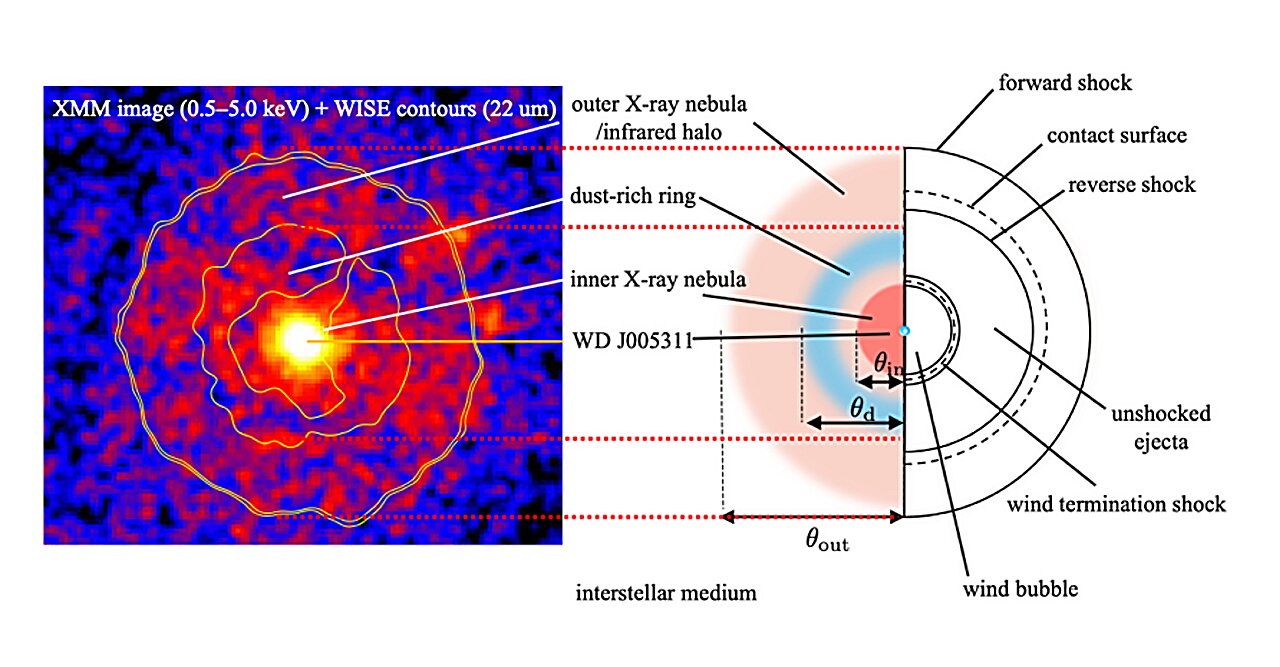These images show the two shock regions of the remnant SNR 1181. The bright white in the center is the white dwarf. Credit: 2024 T. Ko, H. Suzuki, K. Kashiyama et al./ The Astrophysical Journal
A mysterious remnant of a rare type of supernova recorded in 1181 has been explained for the first time. Two white dwarf stars collided, creating a temporary “guest star” now dubbed supernova (SN) 1181, which was recorded in historical records in Japan and elsewhere in Asia. However, after the star dimmed, its location and structure remained a mystery until a team pinned down its location in 2021.
Now, using computer modeling and observational analysis, researchers have reconstructed the structure of the remnant white dwarf, a rare phenomenon that explains the formation of the double shock. They also found that high-speed stellar winds may have only begun blowing from its surface in the past 20-30 years. The work is published in The astrophysical journal.
This discovery increases our understanding of the diversity of supernova explosions and highlights the benefits of interdisciplinary research, combining history with modern astronomy to enable new discoveries about our galaxy.
The year is 1181 and the Genpei War (1180-1185) has recently begun in Japan. It will result in a shift of political power from aristocratic families to the new military-based shogunate, based in the coastal city of Kamakura, near present-day Tokyo.
An account of this tumultuous period was compiled in a diary format in the Azuma Kagami. It described not only the lives of people and important events (with varying degrees of accuracy), but also other daily observations, including the appearance of a new star.
“There are many records of this temporary guest star in historical documents from Japan, China and Korea. At its peak, the star’s brightness was comparable to that of Saturn. It remained visible to the naked eye for about 180 days, until it gradually disappeared from view. The explosion remnant of SN 1181 is now very old, so it is dark and difficult to find,” explained lead author Takatoshi Ko, a doctoral student from the Department of Astronomy at the University of Tokyo.
The remnant of this host star, labeled supernova remnant (SNR) 1181, was found to have been created when two extremely dense, Earth-sized stars called white dwarfs collided. This created a rare type of supernova, a Type Iax supernova, which left behind a single, bright, rapidly rotating white dwarf. Using observations of its position noted in the historical document, modern astrophysicists finally pinpointed its location in 2021 to a nebula in the direction of the constellation Cassiopeia.

This illustration charts the evolution of the SNR 1181 remnant, from its formation when a carbon-oxygen white dwarf and an oxygen-neon white dwarf merged, to the formation of its two shock regions. Credit: 2024 T. Ko
Due to its rare nature and location within our galaxy, SNR 1181 has been the subject of much observational research. This suggested that SNR 1181 consists of two shock regions, an outer region and an inner one. In this new study, the research group analyzed the latest X-ray data to construct a theoretical computer model to explain these observations, and which has reconstructed the previously unexplained structure of this supernova remnant.
The biggest challenge was that, according to conventional wisdom, when two white dwarfs collide like this, they should explode and disappear. However, this merger left behind a white dwarf. The orbiting white dwarf was expected to create a stellar wind (a fast-flowing stream of particles) immediately after it formed. What the researchers discovered, however, was something different.
“If the wind had started blowing immediately after the formation of SNR 1181, we would not have been able to reproduce the observed size of the inner shock region,” Ko said.
“However, by treating the wind onset time as a variable, we were able to accurately explain all the observed features of SNR 1181 and unravel the mysterious properties of this high-speed wind. We were also able to simultaneously track the time evolution of each shock region, using numerical calculations.”
The team was very surprised to find that, according to their calculations, the wind only started blowing very recently, within the last 20-30 years. They suggest that this could mean that the white dwarf has started burning again, possibly because some of the matter ejected by the 1181 explosion fell back to the surface, raising its density and temperature above a threshold that would have restarted the burning.
To validate their computer model, the team is now preparing for further observations of SNR 1181 using the Very Large Array (VLA) radio telescope in the US state of New Mexico and the 8.2-meter-class Subaru Telescope in the US state of Hawaii.
“The ability to determine the age of supernova remnants or the brightness at the time of their explosion through archaeological perspectives is a rare and invaluable asset for modern astronomy,” Ko said. “Such interdisciplinary research is both exciting and highlights the immense potential for combining diverse fields to discover new dimensions of astronomical phenomena.”
More information:
Takatoshi Ko et al, A dynamical model for IRAS 00500+6713: the remnant of a type Iax supernova SN 1181 with a doubly degenerate merger product WD J005311, The astrophysical journal (2024). DOI file: 10.3847/1538-4357/ad4d99
Offered by the University of Tokyo
Quote: Elusive temporary star described in historical documents recreated using new computer model (2024, July 5) Retrieved July 6, 2024 from https://phys.org/news/2024-07-elusive-temporary-star-historical-documents.html
This document is subject to copyright. Except for fair dealing for private study or research, no part may be reproduced without written permission. The contents are supplied for information purposes only.
